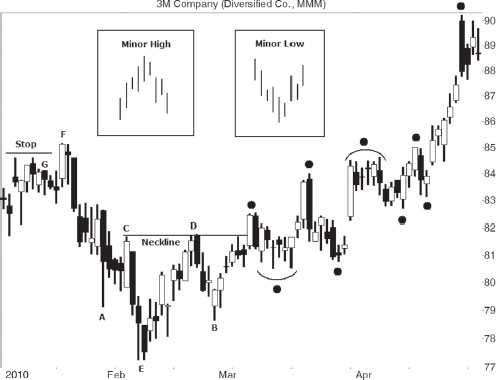MINOR HIGH OR LOW STOP: A GOOD CHOICE
Books about technical analysis often mention the phrases minor high and minor low, but what are they? I define them as short-term turning points in the stock. A minor high is the highest high of the five days surrounding the peak—five days before to five days after the peak. A minor low is similar except that it applies to valleys—a price lower than five days before to five days after the low.
I do not actually count the days surrounding each peak or valley to be sure it qualifies (unless it is during a test, in which case it is done automatically, and I often use two, three, or five days), rather, I visually qualify it. I am just looking for significant turning points.
Figure 3.1 shows minor highs at points C and D, and minor lows at A, B, and E. The AEB configuration is a head-and-shoulders bottom, in case you are into chart patterns. Some of the minor highs (point C, for example), are not the highest peaks within five days since higher prices precede or follow. Not all minor highs or valleys are identified, and the black circles highlight other minor highs or lows. The two insets show the ideal type of turn you are looking for.
Figure 3.1 Minor highs and minor lows represent short-term turning points.

The reason I mention all of this is that minor highs and lows are favorite hiding places for stop loss orders. For example, if you identify ...
Get Trading Basics: Evolution of a Trader now with the O’Reilly learning platform.
O’Reilly members experience books, live events, courses curated by job role, and more from O’Reilly and nearly 200 top publishers.

